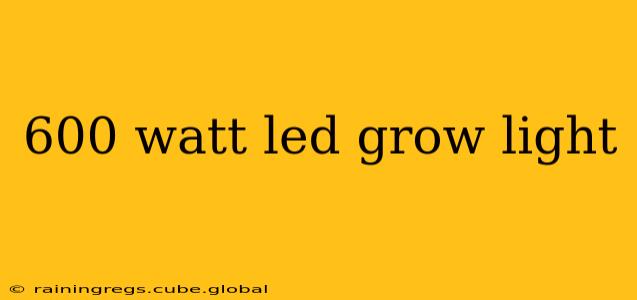Choosing the right grow light is crucial for successful indoor gardening. A 600-watt LED grow light offers a powerful solution, but understanding its capabilities and limitations is key to making an informed purchase. This guide will delve into the specifics of 600-watt LED grow lights, addressing common questions and concerns.
What are the benefits of using a 600-watt LED grow light?
600-watt LED grow lights offer several advantages over traditional high-pressure sodium (HPS) or metal halide (MH) lamps. Their primary benefit is significantly higher energy efficiency. LEDs produce more usable light (photosynthetically active radiation or PAR) per watt consumed, resulting in lower electricity bills and reduced heat output. This reduced heat means less need for expensive cooling systems, further saving money and energy. Furthermore, LEDs boast a longer lifespan than HPS or MH bulbs, reducing replacement costs and maintenance. Finally, LEDs are more environmentally friendly due to their lower energy consumption and lack of harmful materials like mercury.
How much area can a 600-watt LED grow light cover?
The coverage area of a 600-watt LED grow light depends on several factors, including the light's design (full-spectrum vs. specific wavelengths), the height of the light above the plants, and the specific needs of the plants being grown. Generally, a 600-watt LED grow light can effectively cover an area of 4x4 feet to 5x5 feet. However, for optimal results, especially with taller plants or those requiring intense light, it's best to use multiple lights or strategically position the light to ensure even coverage across the canopy. Always check the manufacturer's specifications for recommended coverage.
What is the best spectrum for a 600-watt LED grow light?
The ideal spectrum for a 600-watt LED grow light depends on the growth stage of your plants. Full-spectrum lights, which mimic natural sunlight, are generally suitable for all growth stages. However, some growers prefer lights with adjustable spectrums, allowing them to fine-tune the light's color temperature (measured in Kelvin) to optimize for vegetative growth (cooler temperatures, around 6500K) or flowering (warmer temperatures, around 3000K). A balanced spectrum with a good mix of red and blue wavelengths is essential for photosynthesis and healthy plant development.
Are 600-watt LED grow lights suitable for all plants?
While 600-watt LED grow lights are powerful and versatile, their intensity might be excessive for some smaller or less light-demanding plants. For delicate seedlings or smaller plants, it's crucial to adjust the light's height and potentially use lower wattage grow lights or supplemental lighting. Conversely, larger plants or those in the flowering stage often benefit from the intense light output of a 600-watt LED. Always research the specific light requirements of your chosen plants to determine whether a 600-watt LED is the right choice.
How much does a 600-watt LED grow light cost?
The cost of a 600-watt LED grow light varies considerably depending on the brand, features, and quality of components. Expect prices to range from a few hundred dollars to over a thousand dollars. Higher-priced lights often offer superior build quality, more advanced features (like adjustable spectrum and dimming controls), and longer warranties. It's important to weigh the initial investment against the long-term benefits of energy savings and extended lifespan.
How much electricity does a 600-watt LED grow light use?
A 600-watt LED grow light consumes approximately 600 watts of electricity per hour when in operation. The actual energy consumption will vary slightly depending on the light's design and efficiency, but this figure provides a good estimate. To calculate the monthly cost, multiply the wattage by the number of hours of daily use, divide by 1000 to convert to kilowatt-hours (kWh), and then multiply by your local electricity rate.
This guide provides a foundation for understanding 600-watt LED grow lights. Remember to always consult the manufacturer's instructions and research the specific needs of your plants for optimal results. Happy growing!
